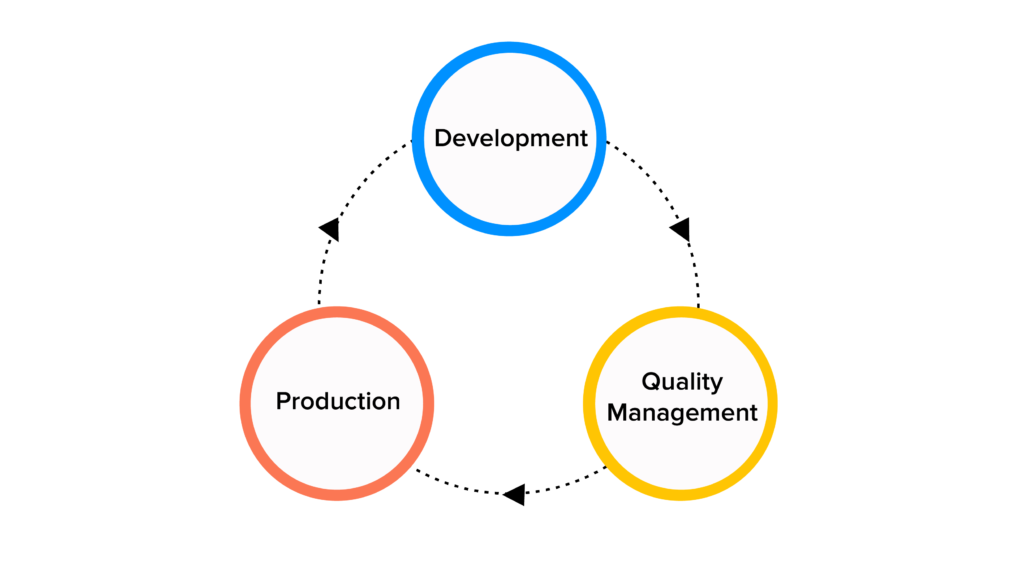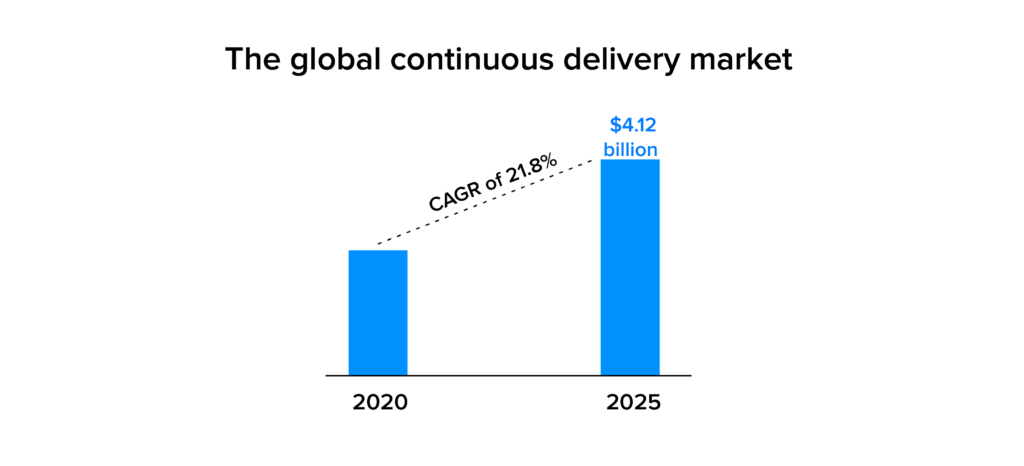- How Is Continuous Delivery A Business Transformation Process?
- Fundamental statistics of continuous delivery as a digital transformation accelerator
- Key metrics that define an organization's performance
- What is Continuous Deployment?
- How Does Digital Transformation Benefit From Continuous Delivery?
- 1. Streamlined workflows
- 2. Happy teams
- 3. Decreased staffing costs
- 4. Better quality and speed
- 7 Steps On How To Implement Continuous Delivery?
- Final words
The COVID-19 pandemic has drastically changed how organisations work. Embracing continuous delivery has now become a crucial approach to lower down the rate of failure when it comes to software projects and adapt to the rapidly changing world around us.
In today’s world, organizations are focused on their digital transformational process and goals hence, it is important for them to deliver new applications and services.
Continuous delivery enhances the ability and efficiency of an organization to come up with a faster high quality software product. Today is the era of digital transformation and with the help of continuous delivery we can achieve it easily.
But now more than ever we need to focus on mitigating the risks that come with the quick paced lives our software projects have. Did you know that about 84% of IT projects are doomed to fail? Let’s discuss the rate of failure in detail, shall we?

How Is Continuous Delivery A Business Transformation Process?
In a traditional manner, an end product is delivered only when everything goes as planned, the software has all the features and has no serious bugs in the quality check stage. The user further has to update the product at regular intervals. However in continuous delivery the product is delivered at a much earlier stage of development, while the work on it still continues!
In other words, while the traditional software development techniques lead to additional development time, costs and customer dissatisfaction, DevOps bridges the development and operations gap by overcoming the challenges associated with continuous software delivery.
Continuous delivery allows 360 degree digital transformation by enabling development teams to incorporate automation in delivering updates more rapidly and with fewer errors. It also facilitates the developers to roll out tested codes that are always in the production-ready state.
In simple words, once a new feature or an update is complete, the code is instantly available for deployment. A software is constantly tested for production readiness and evaluation is done automatically whenever a change is required. The entire process can be portrayed through a cycle:

It can help take the customers wishes into account easily while minimizing the errors simultaneously. The digital first approach is anyway the best approach to enhance customer experience. The process of building, testing and producing software faster reduces both cost and time. Further, continuous delivery acts as a digital transformation accelerator.
Fundamental statistics of continuous delivery as a digital transformation accelerator

Are you wondering how and why the continuous delivery market is expanding? Well below are a few reasons for this transformational process:
- Cloud deployed continuous delivery market is expected to have a major market share during the forecast period 2020-2025 owing to growing adoption of cloud based technology across industries.
- Key market players such as Oracle and Microsoft have been helping towards significant market growth in North America.
- Increasing productivity standards of organizations along with fulfilling customer requirements are some of the major driving factors affecting the growth of the continuous delivery market.
Key metrics that define an organization’s performance
- Deployment frequency
- The time cycle of implementation
- Recovery time between failures
Above are the factors that define organization transformation and strategic change. By now you must have understood that with continuous delivery your application is ready to be deployed, but what exactly is continuous deployment capable of doing for your business’s DX efforts? Let’s discuss.
What is Continuous Deployment?
Continuous deployment is a smart strategy for software products wherein any commit that passes the automated testing phase is automatically released into production deployment. It mainly focuses on minimizing the manual tasks and adopting a unified pipeline that will integrate and deploy tasks as and when they happen.
The organizations that have higher deployment frequency, less time frame to go live, and less recovery time between failures, see significantly lower failure rates in their software projects. How an organization benefits from continuous deployment becomes the deciding factor between a high performing and a low performing organization.
How Does Digital Transformation Benefit From Continuous Delivery?
1. Streamlined workflows
Continuous delivery accelerates digital transformation by automating workflows. It ensures that the tasks are completed and the workflows can be tweaked in case of unique requirements. This also boosts enterprise apps’ ROI and DevOps efforts. So, it is understood that efficiency as well as revenue increases.
Here are a few numbers to give you an idea:.
- Amazon deploys every 11.6 seconds
- Netflix’s rate of deployment is 100 times a day
2. Happy teams
The workflow that the team functions on is so efficient plus it provides constructive feedback more often than usual. As a result, the team remains more aligned with the product or service that they are building. Automated processes handle the maximum workload while your team will be free to focus on the work that delivers business value. Ta-da! You have yourself a happy team!
3. Decreased staffing costs
Since most of the manual tasks are now automated, you can balance out your team and obliterate redundant roles. Such cost savings are significant and don’t compromise on the quality of the end product.
4. Better quality and speed
Continuous delivery improves the quality of software products, the problems get fixed quickly. With more testing and validation automated, the speed to market is way faster.
7 Steps On How To Implement Continuous Delivery?
- Set a process: It is always easier to keep a track of things once you have defined a particular process/ workflow. Make sure your development process includes peer reviews, UI/UX reviews and even customer success reviews. This will help you keep a tab on the quality and security of your software product.
- Start small, think big: It is extremely convenient to ensure quality when you release small. If you launch a huge software product at once, the risk of your software product failing is higher than you could imagine. It is better to ship small chunks of codes that define the features of the software product everyday.
- Set metrics and measure success: Setting proper work metrics will help you hit the bull’s eye.
- User story will help you define the requirements from a user’s point of view.
- Acceptance criteria will decide the details of the requirement and how well the product is doing in the targeted market.
- Quality checklist will verify that all the development steps and automated tests have been executed.
- Include the top shots: Make sure that you include teams from user experience (UX), product managers and customer success in the review cycle. It is a good idea for them to monitor the features that are being worked on. The UX team will help improve the user experience before the product goes public. The customer success team inputs are critical since they already know best about customer’s expectations. This will prove to be the best decision to avoid unnecessary work after the product is launched.
- Use feature switches: A feature switch will turn a particular feature on and off. Deploy and observe the needs of your customers and act accordingly.
- Ensure a healthy work environment: Always remember that it is the team who is working on your superb product. Value them and create a blameless and flexible environment for them to work in.
- Digital transformation consulting: One should never shy away from taking advice from the best digital transformation consulting firms. Digital transformation is not just about using technologies to make business tackle specific customer needs. It is about creating an interconnected ecosystem where the work that is done company wide is transformed for the better. Sometimes asking for help is the biggest favour we do to ourselves, so seek expert advice that can help your software product reach where it deserves to be!
Final words
In the beginning it might seem that continuous delivery is a daunting challenge, but it’s a journey worth taking! Continuous delivery is a series of small steps that you can take to improve your processes. There are solutions like digital transformation strategy consulting at your disposal, to make the entire process more smooth and manageable.
With a little nerve and a lot of forethought, you can get started on a continuous delivery today! It will ultimately generate substantial benefits for you, your team, your company and your customers. It is a win-win for everyone!



How Digital Transformation is Shaping the Next Era of Construction
The construction industry, traditionally slow to adopt new technology, is now actively embracing digital transformation, marking a significant shift towards modernization and increased productivity. This change is all about adopting new solutions that enhance efficiency, safety, and project management, offering significant benefits to businesses. While the complexity of construction projects and coordination among multiple parties…

How Digital Twins Act as Key to Smarter and More Agile Manufacturing Processes - 10 Use Cases and Examples
Tapping into the potential of digital twins in manufacturing, businesses today are creating a transformative virtual, real-time counterpart of physical systems, making it easier to monitor, assess, and optimize their manufacturing operations. McKinsey highlights the value of this approach, pointing out how “a company with a robust digital-twin platform can conduct comprehensive full-product simulations in…









